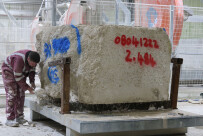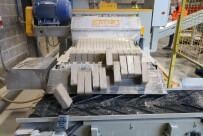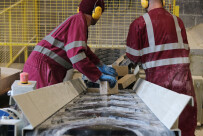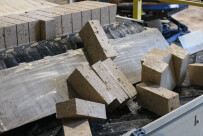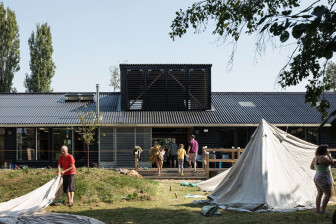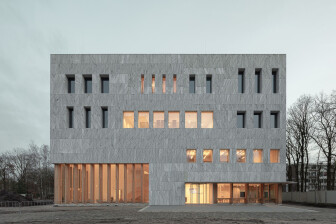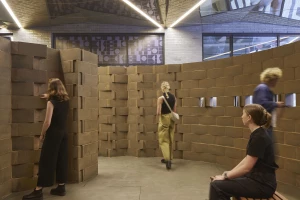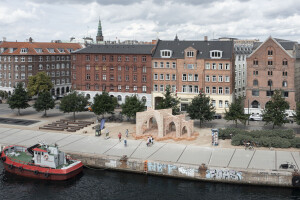A stone brick is a sustainable building material made using stone blocks and slabs that do not meet the expectations of today’s sanitized stone ranges. Stone bricks are an environmentally friendly and aesthetically pleasing contemporary building material. These bricks have a carbon intensity reduction of around 75 percent when compared with traditional clay-fired bricks. The carbon footprint of a stone brick is therefore a quarter of that attributed to a clay brick. (Carbon intensity refers to “the emission rate of a given pollutant relative to the intensity of a specific activity or an industrial production process.”)
Albion Stone and Portland Stone
Originally established in 1927, Albion Stone, a family-run company, secured the lease for its first Portland Stone quarry in 1979. Portland Stone is a limestone quarried on the Isle of Portland, a rocky peninsula on the south coast of England. The stone is often associated with historically significant buildings, most notably in London: St. Paul’s Cathedral, Palace of Westminster, and Tower of London to name a few. Michael Poultney, Albion Stone’s Managing Director, relocated the factory to Portland and switched from quarrying to “more environmentally sensitive mining.”
Albion Stone has invested in advanced machinery and technology to manufacture Heritage Portland Stone Bricks from blocks of Portland Stone. “The blocks are made up of what we refer to as ‘unloved’ stone because they have a range of geological characteristics (shells, voids, markings). The unloved stone, while structurally sound, lacks the aesthetic consistency that is often traditionally desired by architects,” explains Michael Poultney. “However, this is changing — when transformed into bricks, the diverse features of the stone are more appreciated.”
Albion Stone now has over 20,000 cubic meters (approx. 706,290 cubic feet) of “unloved” Portland Stone in its reserves.
Stone and embodied carbon
Stone is a natural, low-carbon, robust, and reusable material. In construction, stone is a viable alternative to both concrete and steel, especially in terms of its compressive strength and lower carbon emissions: “‘General stone’ has a carbon footprint of 0.079kg carbon per kg of stone. Concrete’s is 0.15kg/kg and steel’s 2.8kg/kg” (Webb, 2020). Unlike concrete and steel, stone begins with zero carbon and does not need to be manufactured. Energy is required to extract stone from the earth and to process it, however the embodied carbon is still lower, especially when stone is locally sourced. Embodied carbon is further reduced where electric machinery and transportation are powered by renewable energy sources.
In a report by the World Green Building Council (Adams et al., 2019), the organization sets out a vision for a 40 percent reduction of embodied carbon in all new buildings, infrastructure, and renovations by 2030 (and net zero embodied carbon by 2050). The council notes that embodied carbon emissions have historically been overlooked, yet they account for 11 percent of global carbon emissions. One way to tackle these emissions is to use materials with less carbon intensity — one such material is stone brick.
Stone bricks are not heated (like traditional clay bricks), contributing to their low embodied carbon. Albion Stone’s stone bricks can reduce the embodied carbon of external walls by 75 percent: stone brick 45kgCO2/tonne vs clay brick 213kgCO2/tonne.
Making stone bricks
Portland Stone is cut into brick-sized pieces utilizing a relatively simple and low-energy process — waste is reduced by making use of stone that has already been mined. “The blocks are cut using wire saws, much like cutting a loaf of bread,” says Michael Poultney. “The slabs are then put on a purpose-built brick line — adapted from a paving stone line.” A single-bladed saw cuts these into 215-centimeter-long stone brick strips; a conveyer separates the brick strips from smaller offcuts (the offcuts are crushed into aggregate). The strips then pass through a multi-bladed saw, making the final stone bricks. The bricks are placed on pallets, ready for use in projects that embrace the “visual inconsistencies” of this natural material.
Stone bricks can replace clay bricks in most circumstances, for use in cavity walls, solid walls, joints, and pointing. Albion Stone’s Heritage Portland Stone falls within the range of 40 to 60 MPa — at the upper end of masonry bricks; moreover, the stone is frost and fire resistant.
“Brick from a Stone”
Albion Stone and Hutton Stone (a supplier of natural and sustainable UK sandstone) have commissioned London-based architecture studio Artefact to design a 3-meter-high (10-feet-high) stone brick installation for Clerkenwell Design Week 2024. “Brick from a Stone” will showcase the use of stone bricks, a material that both Albion Stone and Hutton Stone are launching this year. (Hutton Stone will launch sandstone bricks.)
Find examples of projects using Albion Stone on Archello.
References
Adams, M., Burrows, V. and Richardson, S. (2019) Bringing embodied carbon upfront: Coordinated action for the building and construction sector to tackle embodied carbon. rep. World Green Building Council. Available at: https://worldgbc.s3.eu-west-2.amazonaws.com/wp-content/uploads/2022/09/22123951/WorldGBC_Bringing_Embodied_Carbon_Upfront.pdf (Accessed: 15 April 2024).
Webb, S. (2020) Why the time is ripe for a return to Stone as a structural material, RIBA Journal. Available at: https://www.ribaj.com/intelligence/stone-as-a-structural-material-embodied-carbon-sustainability (Accessed: 15 April 2024).


















